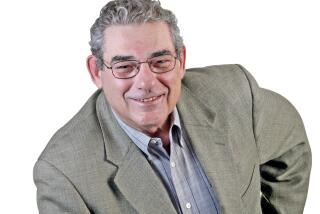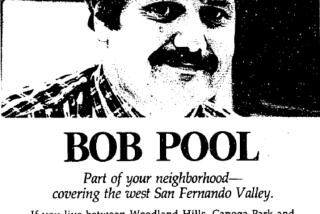Times writer made colorful characters his beat
Charles Hillinger, the Los Angeles Times’ retired roving feature writer and columnist who traversed the highways and byways of California, America and beyond in pursuit of colorful characters and human-interest stories, has died. He was 82.
Hillinger, who battled melanoma cancer for 18 months and was hospitalized in early April, died in his sleep Monday evening at a nursing home in Rancho Palos Verdes, said his son, Brad.
Beginning his career at The Times in 1946 in the editorial library, Hillinger soon became a general-assignment reporter. He eventually began focusing on feature writing, and wrote nearly 6,000 human-interest stories before retiring from the paper in 1992.
His feature stories and 1985-91 column, “Charles Hillinger’s America,” were distributed by the Los Angeles Times-Washington Post News Service to more than 600 newspapers.
As a Times reporter, Hillinger had his share of interesting assignments.
He covered the Beatles during their visit to Los Angeles in 1964 to perform at the Hollywood Bowl, providing a behind-the-scenes report on the “mop-haired Liverpudlians” as they relaxed in their Bel-Air hideaway, where they swam and played cowboys with toy pistols sent over by Elvis Presley.
He also was aboard the aircraft carrier Hornet in 1969 to report on the historic splash-down in the Pacific of the Apollo 11 mission-to-the-moon astronauts -- “back home from man’s greatest adventure.”
But it’s for his stories about people from all walks of life -- and their sometimes unusual pursuits -- that Hillinger is best remembered.
He called them “slices of America” and they were, as former Times publisher Otis Chandler once put it, “a lively and refreshing contrast to the hard news stories of the day.”
William F. Thomas, the paper’s editor from 1971 to 1989, praised Hillinger for being “a hell of a good reporter” who “never wrote a dull story.”
“He had an amazing amount of energy, and he was a very prolific writer,” said Thomas, who worked closely with Hillinger as metro editor. “He used to have stories stacked on my desk. I kept telling him I couldn’t use him every day without wearing out the public, but they were all good.”
As a staff writer, Hillinger had the luxury of picking his own subjects -- and a diverse lot it was.
He flew over Kansas with crop artist Stan Herd to see his “latest living mural” -- a huge vase with three sunflowers as large as 14 football fields.
And he watched farmer Dave Anders play cards with a group of pals in the K-B Cafe in aptly named Starkweather, N.D., where the outside temperature was 15 below and the wind-chill factor was minus 45.
“One good thing about a day like this,” Anders observed, “the mosquitoes aren’t biting.”
But Hillinger was always on the lookout for eccentrics, and California supplied him with enough of them to fill a book: “California Characters: An Array of Amazing People,” published by Capra Press in 2000.
The book chronicles Hillinger’s encounters with people such as Walkin’ George, Spaceship Ruthie, Shopping Cart Dougherty and Seldom Seen Slim, the latter being a 78-year-old prospector and “the last man in Ballarat, a tiny ghost town on the western edge of Death Valley.”
Hillinger’s career in print was often compared to that of a legendary TV journalist who also spent his time on the road seeking stories that other reporters overlooked or purposely ignored: the late CBS News correspondent Charles Kuralt.
“Charles Hillinger has been a hero of mine since I first started reading his stories in the Los Angeles Times back in the sixties,” Kuralt wrote in the foreword to “Charles Hillinger’s America: People & Places In All 50 States,” a 1996 book published by Capra Press.
“He was always on the go, like the wandering scribes of yore. . . . But it seemed to me right from the beginning that Chuck Hillinger was a direct spiritual descendant of the greatest of them all, Ernie Pyle . . . .
“He shows up and listens and understands, discovers things he didn’t know before, then sits down and writes plain stories about plain people which tell the readers things they didn’t know before either, or hadn’t thought about.”
And as Jonathan Kirsch observed in his review of “California Characters” for The Times, Hillinger wrote about his subjects with “insight and empathy.”
“Hillinger’s book is never a freak show,” Kirsch wrote, “and more often than not the profiles are little morality plays.”
Take Hillinger’s 1968 encounter with Clint Wescott, a grizzled homeless man in downtown Los Angeles who lived at the base of a Bunker Hill cliff.
After Hillinger’s story ran, a lawyer in Burnt Hill, N.Y., contacted him to say he had been searching for Wescott for seven years and had nearly $20,000 in two bank accounts that belonged to him.
Wescott, however, wanted nothing to do with the unexpected windfall -- even though he had only 44 cents in his pocket.
“Hand me a dollar. I’ll take it and buy a little drink, a little smoke,” he told Hillinger in a follow-up story. “But I don’t want a huge wad of money like that. . . . You know, all I want out of life is a loaf of bread, a pound of baloney, a hunk of cheese, good health. I’ve got all that here. I’m at peace with the world.”
Hillinger, who won his share of writing awards over the years, also wrote the books “Hillinger’s California,” “Charles Hillinger’s Channel Islands” and “The California Islands.” Also, he edited and organized “Bel-Air Country Club: A Living Legend.”
Nearly 100 segments of NBC’s 1979-84 human-interest series “Real People” were based on Hillinger’s newspaper stories.
Although he retired from The Times in 1992, Hillinger continued to travel and write stories for more than 30 national magazines.
“No matter how old you are or how young, you can get caught up in the excitement of writing,” Hillinger told UCLA’s Daily Bruin in 1999. “It’s the most wonderful life a person could ever imagine, and I enjoyed every minute of it.”
Hillinger was born April 1, 1926, in Evanston, Ill., and later moved to Park Ridge, Ill., where he launched his career in seventh grade -- as a columnist and circulation manager for the weekly Park Ridge Advocate.
As a junior and senior in high school, he was a copy boy and feature writer for the Chicago Tribune.
He then served in the Navy during World War II and later graduated from UCLA with a degree in political science.
As a Times reporter, Hillinger traveled around the world twice, including visits to Siberia and the north and south poles. He survived five airplane crashes.
During the more than six-year run of “Charles Hillinger’s America,” he traveled to all 50 states (a dozen of them twice), the District of Columbia, Puerto Rico and the Virgin Islands.
As he wrote in his 296th -- and final -- column on March 31, 1991: “What an incredible journey.”
In addition to his son, Hillinger is survived by his wife of 59 years, Arliene; his daughter, Tori Lindman; and four granddaughters.
A memorial service will be held at 11 a.m. Tuesday at Rolling Hills Covenant Church, 2222 Palos Verdes Drive North, Rolling Hills Estates.
--


